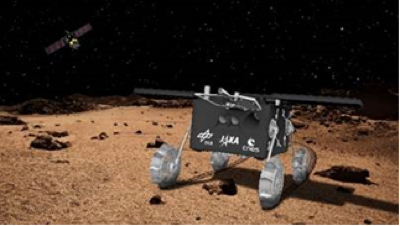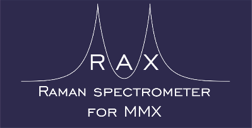The Mars Moon eXploration (MMX) mission by the Japan Aerospace Exploration Agency, JAXA, is going to explore the Martian moons Phobos and Deimos. It will investigate the moons remotely and also return samples from Phobos back to Earth. In addition, MMX will deliver a small (about 25 kg) Rover to the Phobos surface.
The Rover (provided by CNES and DLR) accommodates a payload of four scientific instruments: a Raman spectrometer (RAX) to measure the mineralogical composition of the surface material, a stereo pair of cameras looking affront NavCam (also used for navigation), to provide the properties of the investigated area, a radiometer (miniRAD) to measure the surface brightness temperature and determine thermal properties of both regolith and rocks (if in the field of view), and two cameras looking at the wheel-surface interface, WheelCam, to investigate the properties and dynamics of the regolith. The cameras will, thus, serve for both, technological and scientific needs.
After delivery from the main spacecraft, the Rover shall be able to operate for about 100 days and investigate the terrain along its path of several tens of meters. This will allow putting the returned samples into context, providing ground truth, studying the surface heterogeneity and obtaining information on the physical properties of undisturbed surface material, as well as dynamical properties of the regolith subject to the wheel motions.
MMX is planned to be launched in September 2024, the Rover delivery is currently foreseen for 2027. The Rover is a contribution by the Centre National d’Etudes Spatiales (CNES) and the German Aerospace Center (DLR) with additional contributions from INTA (Spain) and JAXA.

Mineralogy is the key to understanding the origin of Phobos and its position in the evolution of the solar system. In situ Raman spectroscopy on Phobos is an important tool to achieve the scientific objectives of the Martian Moons eXploration (MMX) mission, and maximize the scientific merit of the returned samples by characterizing the mineral composition and heterogeneity of the surface of Phobos.
CAB YouTube channel: https://www.youtube.com/c/CentrodeAstrobiologia








